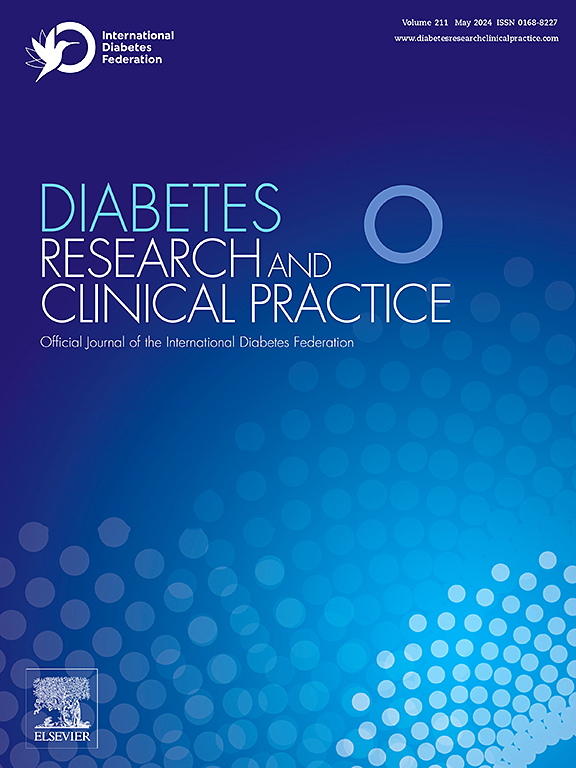坚持每周一次胰高血糖素样肽1受体激动剂治疗可降低主要不良心血管事件的风险:对2型糖尿病和动脉粥样硬化性心血管疾病患者的回顾性分析
IF 6.1
3区 医学
Q1 ENDOCRINOLOGY & METABOLISM
引用次数: 0
摘要
目的评估持续使用每周一次胰高血糖素样肽-1受体激动剂(OW GLP-1 RAs)与2型糖尿病(T2DM)和动脉粥样硬化性心血管疾病(ASCVD)患者主要不良心血管事件(MACE)风险之间的关系。方法:我们使用Optum研究数据库识别2018年1月1日至2022年11月30日期间启动OW GLP-1 RAs的患者。根据患者连续用药3个月后是否存在≥60天的药物供应缺口,将患者分为持续用药或非持续用药。调整的时变Cox比例风险模型评估了持续状态与2点MACE、卒中和心肌梗死(MI)风险之间的关系。结果持续治疗(n = 18,849)和非持续治疗(n = 10,667)患者的平均随访时间分别为418天和741天。持续性和非持续性患者的平均(SD)持续时间分别为418(339)天和288(234)天。持续治疗可显著降低2点MACE、卒中和心肌梗死的风险(p <;0.001)。相应的hr (95% CI)分别为0.696(0.626-0.774)、0.668(0.573-0.777)和0.710(0.621-0.813)。结论:在现实世界中,坚持OW GLP-1 RA治疗与T2DM和ASCVD患者MACE风险显著降低相关。本文章由计算机程序翻译,如有差异,请以英文原文为准。

Persistence with once-weekly glucagon-like peptide 1 receptor agonist therapy decreases the risk of major adverse cardiovascular events: A retrospective analysis of patients with type 2 diabetes mellitus and atherosclerotic cardiovascular disease
Aims
To assess the association between remaining persistent with once-weekly glucagon-like peptide-1 receptor agonists (OW GLP-1 RAs) and the risk of major adverse cardiovascular events (MACE) among patients with type 2 diabetes mellitus (T2DM) and atherosclerotic cardiovascular disease (ASCVD).
Methods
We used the Optum Research Database to identify patients who initiated OW GLP-1 RAs between 1/1/2018–11/30/2022. Patients were classified as persistent or non-persistent depending on whether there was a ≥ 60-day gap in medication supply after they continuously used the medication for the first three months. Adjusted time-varying Cox proportional hazards models assessed the associations between persistence status and risks of 2-point MACE, stroke, and myocardial infarction (MI).
Results
Persistent (n = 18,849) and non-persistent (n = 10,667) patients were followed for an average of 418 and 741 days, respectively. Mean (SD) persistence was 418 (339), and 288 (234) days for persistent and non-persistent patients, respectively. Remaining persistent was associated with significantly lower risks of 2-point MACE, stroke, and MI (all p < 0.001). The corresponding HRs (95 %CI) were 0.696 (0.626–0.774), 0.668 (0.573–0.777), and 0.710 (0.621–0.813).
Conclusions
Persistence with OW GLP-1 RA therapy was associated with significantly lower MACE risk among patients with T2DM and ASCVD in a real-world setting.
求助全文
通过发布文献求助,成功后即可免费获取论文全文。
去求助
来源期刊

Diabetes research and clinical practice
医学-内分泌学与代谢
CiteScore
10.30
自引率
3.90%
发文量
862
审稿时长
32 days
期刊介绍:
Diabetes Research and Clinical Practice is an international journal for health-care providers and clinically oriented researchers that publishes high-quality original research articles and expert reviews in diabetes and related areas. The role of the journal is to provide a venue for dissemination of knowledge and discussion of topics related to diabetes clinical research and patient care. Topics of focus include translational science, genetics, immunology, nutrition, psychosocial research, epidemiology, prevention, socio-economic research, complications, new treatments, technologies and therapy.
 求助内容:
求助内容: 应助结果提醒方式:
应助结果提醒方式:


